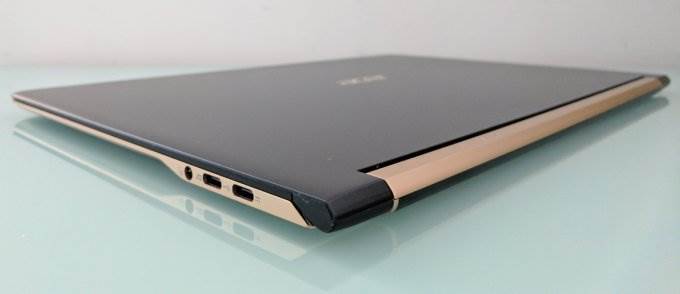Acer’s 13 inch Swift 7 laptop is super-slim, super-lightweight, and super-quiet, thanks to a fanless design. It’s a stylish laptop with one of the best keyboards of any Acer laptop I’ve tested, and it also features a wide, comfortable touchpad below the keys.
There must be a catch, right? Well, there is… kind of.
The Acer Swift 7 is a premium laptop that sells for about $1050, which makes it fairly expensive for a Windows laptop. And despite that relatively high price tag, it’s slower than the cheaper Acer Aspire S 13 notebook I reviewed recently.
That’s because the Swift 7 achieves its slim, fanless design with the help of a low-power Intel Kaby Lake-Y series processor instead of the more powerful Intel U-series chips you’d typically find in a laptop in this price range.
Nonetheless, Intel has really optimized its 7 watt processors in a way that makes it easy to forget that this computer has one. In day to day use, the Swift 7 felt just as responsive as the Aspire S 13… and a heck of a lot quieter, since there’s no high-pitched fan noise.
Acer loaned me a Swift 7 to review recently, and I’ve really been enjoying my time with it. It’s a super-portable notebook that feels powerful enough to justify the high price tag, because it’s speedy enough to use as your only notebook for most common computing tasks. But it does lack some premium touches that you’ll find on other notebooks: there’s no touchscreen display, for instance, and the keyboard is not backlit.
Battery life could also be better, and the computer also doesn’t have an awful lot of ports.
So is it worth the asking price? Read on to find out.
[embedded content]
Overview
Let’s start with those ports. Here’s the cool thing about them: you can use either one to charge the laptop. Just plug the included USB Type-C power adapter into either port to start charging the laptop’s battery while the other port remains free for a flash drive, video cable, or other accessories.
Those two ports are packed pretty close to one another on the right side of the laptop, next to a 3.5mm headset jack.
If you have chunky USB accessories, it’s entirely plausible that a flash drive or other dongle could block the second port, but I haven’t run into that problem yet.
Laptops which only have USB-C ports are a bit of an annoyance for now, because you may need to buy a bunch of new adapters or accessories for the notebook. But with a growing number of laptops launching without HDMI, Ethernet, or full-sized USB ports, I suspect we’ll see plenty of new USB-C accessories in the coming years.
To help ease the transition, Acer ships two adapters with the laptop: a USB-C to USB-A adapter and a USB-C to HDMI dongle.
One thing that this laptop doesn’t come with? An SD card reader. If you plan to copy files from a camera or another device, you may need to buy a USB card reader (or connect your camera via a USB cable or WiFi).
Personally I’ve already started to make the transition: I have a USB-A to USB-C adapter that I can use to connect my wireless mouse, and a USB-C hub with four USB-A ports and and Ethernet jack when I need more connection options.
OK, but enough about ports, let’s talk specs.
The laptop Acer loaned me features an Intel Core i5-7Y54 Kaby Lake processor with Intel HD 615 graphics, 8GB of RAM, and 256GB of solid state storage. It has a 13.3 inch, 1920 x 1080 pixel display and the notebook ships with Windows 10 Home software.
The computer measures 12.8″ x 9″ x 0.4″ and weighs about 2.5 pounds, making it one of the thinnest laptops on the market. While there are a few lighter options available, the Acer Swift 7 is certainly light enough to make you check your bag a few times after you leave the house, for fear that you might have forgotten to pack the laptop.
Acer’s laptop has an aluminum unibody design, with a gold-colored base, a black island-style keyboard layout, and a black bezel around the edge-to-edge glossy glass display.
The lid and bottom of the laptop are also black (and they’re kind of fingerprint magnets).
There are stereo speakers on the bottom of the laptop, and they’re relatively loud and clear considering their size and location.
Below the touchpad there’s a precision touchpad that measures 5.5″ x 2.5″. It’s large enough that you might find yourself placing your palm on the touchpad as you type, but palm rejection seems to be pretty good: I never had the cursor move while I was typing.
As for the keyboard itself, I’ve had a pet peeve with Acer laptops for ages: the company usually crams the arrow and page up/page down keys into a tiny space in the lower right corner, which means there are six tiny keys in the space usually reserved for three full-sized keys.
Acer did something different with this laptop: the arrow keys are still half-height, but they’re the only physical keys in the lower-right corner, making it much easier to tell which key you’re pressing without looking at the keyboard. For this reason, I find touch-typing to be much easier on this laptop than the Acer Aspire S 13.
Each arrow key also serves double-duty as a Fn key: left-arrow is Home, right-arrow is End, up-Arrow is Page Up, and down-arrow is Page Down. The volume and brightness keys are all in the Fn row above the number keys.
All told, the Swift S7 is a sleek-looking, light-weight laptop with an excellent keyboard and touchpad. Another USB port or two might have been nice (there are no ports at all on the left, side, so you’d think there’d be room). But overall, the design is fine… as long as you don’t need a touchscreen, a matte display, or a backlit keyboard.
But what about performance?
Performance
Part of the reason the Acer Swift 7 can operate without a fan is because it has a relatively low-power processor that doesn’t generate as much heat as the ones found in most laptops.
Acer chose an Intel Core i5-7y54 Kaby Lake processor for this laptop. It’s the spiritual successor to last year’s Core M5-6Y57 Skylake processor, but the newer chip operates at higher clock speeds, features more powerful graphics, and comes with energy efficiency improvements… all of which led Intel to change the branding of this Y-series chip from Core M to Core i.
That move could lead to some confusion among computer shoppers: not all Core i5 chips are equal this year. But you know what? After spending two weeks testing this laptop, I’m almost convinced Intel made the right decision.
In terms of day to day performance, there’s not much difference between the Acer Swift 7 with its Core i5 Kaby Lake-Y processor and my Acer Aspire S 13 laptop with a Core i7-6500U chip.
Sure, benchmarks show that the notebook with the Core i7 chip can transcode video more quickly, render graphics in video games more efficiently, and generally do a better job with number-crunching tasks than the the Swift 7. But both laptops boot in a few seconds, launch applications quickly, and have no trouble playing HD video, multitasking, or allowing me to surf the web with up to 20 browser tabs open at the same time (while video is playing in one).
If you’re looking for a gaming machine, this isn’t it. And if you’re looking for the fastest processor you can get for your money, this laptop doesn’t have it. In fact, there are Core i5 chips that are several years old that will probably outperform the Core i5-7Y54 chip in some tasks. But I would never call this laptop sluggish.
That said, the Acer Swift 7 is a laptop that sells for around $1000 or more… so you’ll have to decide if not-sluggish is a good enough metric at a time when there are plenty of other laptops that sell for hundreds of dollars less, but which offer better performance.
And there’s one more performance measure to consider: battery life.
Acer says the Swift 7 should get up to 9 hours of battery life. It doesn’t.
In my tests, about 5 hours of run time seems more realistic. If you’re wondering how it’s possible that a laptop with a 4.5 watt processor has shorter battery life than many models with 15 watt chips, just look at the notebook’s slim profile: one of the concessions Acer made in order to keep the laptop just 0.4 inches thick is to use a 4 cell, 2770 mAh battery.
You may be able to squeeze a little more run time out of the laptop if you use it differently: battery life tests are generally pretty subjective, and other reviewers seem to get closer to 7 hours of run time while web surfing or streaming videos.
But whenever I used the Swift 7 as a work machine, I would open at least 8 browser tabs in Google Chrome for researching and writing articles, use the Irfanview (and sometimes GIMP) programs to edit images, and sometimes play music or videos while working. Screen brightness was usually somewhere between 30% and 50%.
Under those conditions the battery typically lasted for about 4.5 to 5.5 hours.
And that’s for a brand new notebook. I suspect that after a few years usage, the battery won’t last nearly as long between charges. Like most thin and light notebooks, the Acer Swift 7 has a non-removable battery, which means that if you plan to hang onto this laptop for a long time, you may find yourself looking for an external battery powerful enough to charge the laptop.
It’s a shame that the laptop has mediocre battery life though, because I’d be willing to forgive most of its other flaws. But this one is hard to overlook.
Linux
The Acer Swift 7 ships with Windows 10, and that’s the operating system I used for most of my time with the laptop. But I wanted to see whether it would work with other operating systems, so I dug into the UEFI/BIOS settings to find out.
In order to get into those settings, all you need to do is turn off the computer, press the power button, and then hit the F2 key as the system is booting.
From there you can change the boot priority order, disable or enable Secure Boot, and make other…





![[CES 2026] Quest For Perfect Color…Samsung To Push](https://loginby.com/itnews/wp-content/uploads/2025/12/CES-2026-Quest-For-Perfect-Color…Samsung-To-Push-100x75.jpg)

